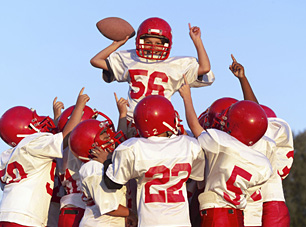Kids and Concussions: Pop Warner Uses Its Head
By K. Jeffrey Miller, DC, MBA
In early June the Pop Warner youth football league announced a new concussion awareness initiative in response to the growing number of concussions suffered by players each year.
It also follows closely the recent suicide of former NFL player Junior Seau, who suffered from post-concussion syndrome, and the bounty scandal involving the NFL's New Orleans Saints, who allegedly rewarded players for taking opposing players out of the game.
The occurrence of concussion in football at all levels is significant. Concussions in the sport make up over half of the more than 4 million sport- and recreation-related concussions suffered each year in the United States. The majority of these injuries occur during practice. The new Pop Warner concussion prevention rules include the following:
- Contact during practice is limited to one-third of practice time. With an average practice schedule of nine hours per week, this limits contact to three hours.
- No head-to-head hits are allowed.
- Tackling drills must be initiated within a 3-foot zone. No full-speed or head-on tackling drills beyond 3 feet.
This initiative is a welcome policy for parents of youth footballers. It is also welcomed by health care providers. There will be fewer concussions. The key word in that last statement is fewer. Unfortunately, we cannot say there will be "no" concussions.
 A concussion is a traumatic disruption of cerebral (brain) function. Trauma results in an increased demand for intracellular glucose that cannot be met. The imbalance results in what is thought to be altered cerebral blood flow and a variety of signs and symptoms. In the majority of cases, the condition is transient.
A concussion is a traumatic disruption of cerebral (brain) function. Trauma results in an increased demand for intracellular glucose that cannot be met. The imbalance results in what is thought to be altered cerebral blood flow and a variety of signs and symptoms. In the majority of cases, the condition is transient.
Signs and symptoms of concussion include headache, sleep disturbance, dizziness, confusion, nausea, unsteadiness, difficulty concentrating, disorientation, amnesia, loss of consciousness, irritability, vomiting, visual disturbances, tinnitus, lightheadedness, fatigue, impaired performance and impact seizure. Signs and symptoms are reported by the athlete or observed with physical evaluation.
Structural changes in the brain are not seen on neuroimaging, making concussion predominantly a clinical diagnosis. However, imaging is still a good idea to rule out significant trauma such as a skull or cervical fracture, epidural or subdural hematoma, etc. If imaging is not performed initially, signs and symptoms lasting more than 10 days indicate an immediate need.
Numerous grading scales for concussion have been proposed and utilized over the years. However, the current trend is to simply rate concussions as either simple or complex. Simple concussions are self-resolving, usually within 10 days. They resolve without residuals and the athlete can return to play. Complex concussions have a continued signs and symptoms with complications (convulsions are an example). Lingering signs and symptoms can delay or permanently prevent an athlete's return to play.
If an athlete recovers from a simple concussion, a second concussion from similar trauma may be classified as complex. Concussive traumas seem to have an accumulative effect.

